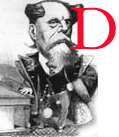[The following is the abstract of a presentation at the 26th Dickens Society Symposium (12-14 July 2021). Many thanks to Sean Grass, Professor of English at the Rochester Institute of Technology and President of the Dickens Society, for providing the list of speakers and sending along to them our invitation to share their presentations with the Victorian Web. — George P. Landow.]

ickens’s portrayal of babyhood comprises comical creations as well as complex symbols and infants as victims of social injustice, yet especially his funny babies are often overlooked. My presentation explores how Dickens satirises the growing commodification of babyhood in Victorian Britain and, in playing with readers’ expectations, produces comical scenes that strengthen rather than undercut his social criticism. His exposure of failed middle-class projects of child rescue urges his readers to reconsider prevailing ideas of charitable intervention, while he uses comically exaggerated infant behaviour to render working-class practices of child care mundane and familiar without sentimentalising them. His representation of working-class baby-minding, a practice that Victorian philanthropists notoriously misunderstood, exemplifies how Dickens could combine comedy and social criticism to draw attention to topical issues, upend clichés, and at the same time create individualised infant characters. His Christmas book for 1848, The Haunted Man and the Ghost’s Bargain, produces a grotesquely comical image of a baby, minded by a small boy, as “Moloch,” a deity demanding child-sacrifice. While Baby Moloch becomes central to a reassessment of emotional attachment, the narrative complicates middle-class rescue work. The simultaneity of the comical baby and infants as symbols of suffering is then further developed in Bleak House (1853), whereas in Our Mutual Friend (1865), the failed rescue of an orphaned toddler dramatises pressing issues involving paid child-minding and unregulated adoption. The analysis of Dickens’s fictional infants simultaneously reveals the different narrative roles of the comical baby in Victorian literature.
Note: Professor Wagner’s presentation has been published as part of her recent Oxford University Press book, The Victorian Baby in Print: Infancy, Infant Care, and Nineteenth-Century Popular Culture. For this author’s many contributions to the Victorian Web, use the site’s search tool.
Last modified 23 September 2010